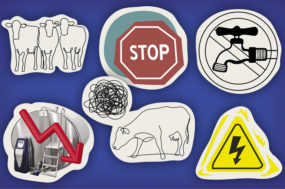In the fall of 2016, DFC contracted Holstein Canada to assess key animal welfare indicators – body condition score, injuries and lameness – on a statistically significant number of cows in each herd. This benchmarking exercise will be conducted on all Canadian dairy farms until fall 2018.
As of June 1, 1,195 herds have been assessed. The cattle assessment provides farms with a benchmark from which they can plan measurable improvement – striving to meet the “excellent” targets.
To reach the excellent targets, 95 percent or more of the animals in a herd must meet the requirement of having a body condition score greater than 2, and 90 percent or above must score well on the indicators of injuries or lameness.
The assessment indicates how well farms comply with a number of important requirements in the Canadian Code of Practice for the Care and Handling of Dairy Cattle.
Following the assessment, farms will receive a summary of their overall herd performance. Now that about 10 percent of Canadian herds have been assessed, it is possible to estimate a national average for each indicator.
In July, farmers began receiving a “peer report” as part of their summary. The report allows individual farmers to compare their herds with the national averages.
The peer report categorizes the result of the herd for each measure in the green (excellent or good results), yellow or red zone. If the herd has a result in the yellow zone, the farmer should consider it as a warning and look to make improvements. If a result falls in the red zone, a farmer must write a corrective action plan and implement it.
Veterinarians, ruminant nutritionists and dairy specialists are good experts to help map out such a plan.
The cattle assessment must be completed within 24 months before the farm is due for a validation for the animal care module of the proAction initiative.
Every two years, prior to validation, farmers will need to have an assessment conducted, with the expectation the results will have improved over the previous assessment for results that fall in the red or yellow zones.
The first assessments show many farms achieving close to – or meeting – the excellence target.
These results indicate farmers are committed to improving issues that may arise on their farms, they value the collaboration of veterinarians and dairy specialists, and are seeking better genetics to increase production or improve longevity and other characteristics.
In the same vein, the assessment of these animal-based measures, and proAction itself, is made possible through the collaboration of multiple partners.
DFC is grateful for the collaboration of farmers, veterinarians, animal science researchers and Holstein Canada, which has resulted in developing practical tools for farmers to continue to be proactive about the care of dairy cattle to measure future improvement.
This will result in healthier and more productive herds. ![]()
Dairy Farmers of Canada
Founded in 1934, Dairy Farmers of Canada (DFC) is the national organization which defends the interests of Canadian dairy farmers and strives to create favourable conditions for the Canadian dairy industry.
Working in accordance with supply management principles, DFC promotes safe, high quality, sustainable and nutritious Canadian dairy products made from 100% Canadian milk through various marketing, nutrition, policy and lobbying initiatives.
Driven by a strong sense of community and pride, DFC and Canadian dairy farmers actively support a number of local and national activities. Visit Dairy Farmers of Canada for more information.








